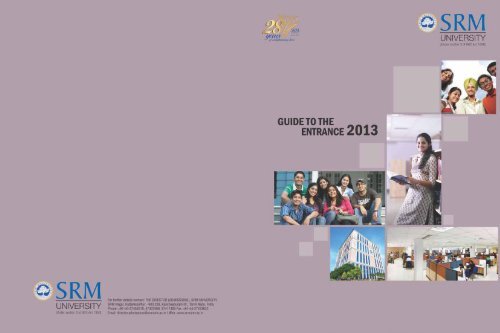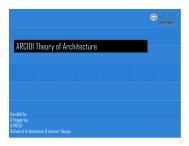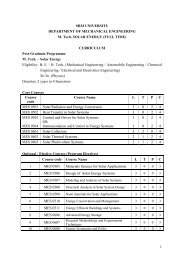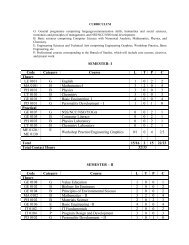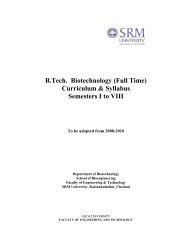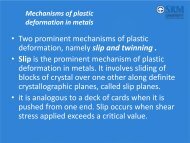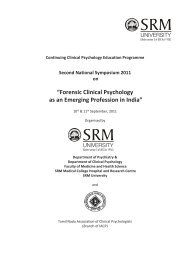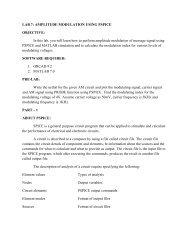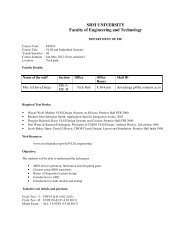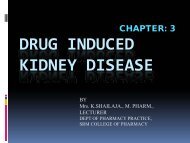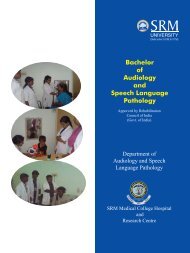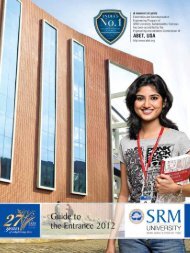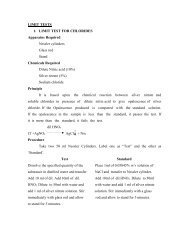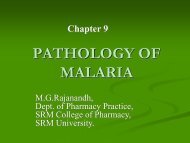Guide to Entrance Exam - SRM University
Guide to Entrance Exam - SRM University
Guide to Entrance Exam - SRM University
Create successful ePaper yourself
Turn your PDF publications into a flip-book with our unique Google optimized e-Paper software.
02<br />
13<br />
21<br />
27<br />
30<br />
32<br />
Contents<br />
Part I: General Information
1. Eligibility<br />
1.1 Nationality<br />
The applicant for admission should be a resident Indian national and<br />
should have studied in schools located in India in the preceding two<br />
years.<br />
1.2 Eligibility Criteria in Qualifying <strong>Exam</strong>ination<br />
Engineering and Technology<br />
Undergraduate Programs<br />
B. Tech.: A pass in 10+2 or its equivalent and (a) For all programs:<br />
Minimum 70% aggregate in mathematics, physics & chemistry<br />
(b) For biotechnology, bioinformatics, biomedical engineering and<br />
genetic engineering: Minimum 70% aggregate in maths / biology,<br />
physics and chemistry.<br />
Part I<br />
General Information<br />
In <strong>SRM</strong>EE-2013<br />
<br />
<br />
<br />
<br />
<br />
<br />
B.Des.: A pass in 10+2 or its equivalent with a minimum <strong>to</strong>tal<br />
aggregate of 70%.<br />
B.Arch.: (a) A pass in 10+2 or its equivalent having a minimum <strong>to</strong>tal<br />
aggregate of 70% with English and Mathematics as subjects of study or<br />
10+3 Diploma (Any Stream) recognised by Central/State Government<br />
with 70% aggregate marks.<br />
(b) A pass in Nai<strong>to</strong>nal Aptitude Test in Architecture ( NATA) conducted<br />
by the Council of Architecture.<br />
No separate entrance examination will be conducted by <strong>SRM</strong> <strong>University</strong>.<br />
However, the candidates have <strong>to</strong> apply in the prescribed application<br />
form for admission <strong>to</strong> B.Arch. program.<br />
Postgraduate Programs<br />
M.Tech.<br />
S. No Specialization Eligibility<br />
(A basic degree or equivalent in the following with a minimum aggregate of 60%)<br />
<br />
<br />
<br />
<br />
<br />
<br />
<br />
<br />
<br />
<br />
<br />
<br />
<br />
<br />
<br />
<br />
<br />
<br />
<br />
<br />
<br />
<br />
<br />
<br />
<br />
<br />
<br />
<br />
<br />
<br />
<br />
<br />
<br />
<br />
<br />
02 03
Health Sciences<br />
S. No Programe Eligibility<br />
( As prescribed for each program with a minimum aggregate of 60%)<br />
Under Graduate<br />
<br />
<br />
<br />
<br />
<br />
<br />
<br />
<br />
<br />
<br />
<br />
<br />
<br />
<br />
<br />
<br />
<br />
<br />
Diploma Courses<br />
<br />
<br />
<br />
<br />
<br />
<br />
<br />
M.Arch.<br />
B.Arch. (or) equivalent<br />
Management<br />
Bachelor of Business Administration (BBA)<br />
<br />
<br />
Postgraduate Program in Management (PGPM)<br />
A Bachelor’s degree with minimum aggregate of 60%. Preference will be<br />
given <strong>to</strong> candidates with work experience of 1 – 2 years.<br />
Postgraduate Program in Retail Management (PGPRM)<br />
A Bachelor’s degree with minimum aggregate of 60% with minimum 2<br />
years of professional experience.<br />
Master of Business Administration (MBA)<br />
A Bachelor’s degree with minimum aggregate of 60%<br />
04 05
Science and Humanities<br />
S. No Programe Eligibility<br />
(As prescribed for each program with a minimum aggregate of 60%)<br />
Science and Humanities<br />
S. No Programe Eligibility<br />
(As prescribed for each program)<br />
Under Graduate<br />
B.Sc<br />
<br />
<br />
<br />
<br />
<br />
<br />
Mathematics <br />
<br />
<br />
B.C.A. <br />
<br />
B.A Journalism &<br />
Mass Communication<br />
B.Com<br />
<br />
<br />
<br />
<br />
Diploma Programs<br />
<br />
<br />
<br />
<br />
B.Ed. <br />
Post Graduat<br />
M.A<br />
<br />
<br />
<br />
<br />
M.Sc<br />
Biotechnology <br />
<br />
<br />
<br />
<br />
<br />
<br />
<br />
<br />
<br />
<br />
<br />
<br />
<br />
<br />
<br />
<br />
<br />
32. M.Ed A degree with B.Ed<br />
PG Diploma<br />
<br />
06 07
1.3 Additional Information<br />
<br />
<br />
the written test/counseling does not necessarily mean acceptance of<br />
the eligibility.<br />
<br />
admitted <strong>to</strong> a program will stand cancelled if he/she does not submit<br />
the relevant documents in original pertaining <strong>to</strong> admission (such as<br />
<br />
<br />
<br />
<br />
In case any discrepancy is noticed, even at a later point of time after<br />
admission, the management reserves all right <strong>to</strong> cancel the candidate’s<br />
<br />
candidate.<br />
2. Admission Procedure<br />
2.1 For B.Tech Program<br />
<br />
Engineering <strong>Entrance</strong> <strong>Exam</strong>ination conducted by <strong>SRM</strong> <strong>University</strong>.<br />
<br />
entrance examination will be called for the counseling <strong>to</strong> be held at the<br />
<strong>SRM</strong> <strong>University</strong> premises in Kattankulathur 603 203, Chennai.<br />
2.2 For B.Arch. Program<br />
<br />
marks secured in the qualifying examination & NATA score.<br />
<br />
<br />
weightage <strong>to</strong> NATA score.<br />
<br />
2.3 For B.Des. Program<br />
Admission <strong>to</strong> B.Des. program will be purely on the basis of performance<br />
in the Higher Secondary examination. Candidates short listed based on<br />
their Higher Secondary marks will be offered admission directly.<br />
2.4 For M.Tech. Program<br />
Admission <strong>to</strong> this program will be on the basis of performance in the<br />
<strong>Entrance</strong> Test conducted by <strong>SRM</strong> <strong>University</strong>. However candidate with<br />
valid GATE score can also apply and will be considered for admission.<br />
Merit list will be prepared and candidates will be called for counseling.<br />
2. 5 For MBA Program<br />
Admission <strong>to</strong> this program will be on the basis of performance in the<br />
<strong>Entrance</strong> Test conducted by <strong>SRM</strong> <strong>University</strong>. However candidates with<br />
valid score in GMAT, CAT, MAT, XAT, TANCET also can apply and will be<br />
considered for admission. Merit list will be prepared, candidates will be<br />
called for group discussion and personal interview and selection will be<br />
made.<br />
2. 6 For PGPM Program<br />
Admission <strong>to</strong> this program will be on the basis of past academic<br />
performance (Minimum 60% in UG) and professional experience.<br />
<br />
interview at <strong>SRM</strong> <strong>University</strong> and selection will be made.<br />
2. 7 For PGPRM Program<br />
Admission <strong>to</strong> this program will be on the basis of past academic<br />
performance (Minimum 60% in UG) and professional experience.<br />
<br />
interview at <strong>SRM</strong> <strong>University</strong> and selection will be made.<br />
2. 8 For MCA Program<br />
Admission <strong>to</strong> this program will be on the basis of performance in the<br />
<strong>Entrance</strong> Test conducted by <strong>SRM</strong> <strong>University</strong>. Merit list will be prepared<br />
and candidates will be called for counseling.<br />
2.9 For M.Arch Program<br />
Admission <strong>to</strong> this program will be on the basis of marks obtained in the<br />
qualifying examination, professional experience and performance in the<br />
interview. Merit list will be prepared and candidates will be admitted.<br />
2.10 For Health Sciences<br />
<br />
<strong>Exam</strong>ination conducted by <strong>SRM</strong> <strong>University</strong> and / or marks secured in the<br />
qualifying examination.<br />
<br />
counseling <strong>to</strong> be held at the <strong>SRM</strong> <strong>University</strong> premises in Kattankulathur<br />
603 203, Chennai.<br />
2.11 For Science & Humanities and BBA<br />
<br />
qualifying examination.<br />
<br />
counseling <strong>to</strong> be held at the <strong>SRM</strong> <strong>University</strong> premises in Kattankulathur<br />
603 203, Chennai.<br />
3. <strong>SRM</strong>EE–2013 Schedules<br />
3.1 For Paper-Pencil exam<br />
Date of examination: 20th April 2013, Saturday.<br />
Timing: 10.00 am <strong>to</strong> 12.30 pm.<br />
3.2 For Online exam<br />
Refer item 22 (c) in Part II<br />
4. <strong>SRM</strong>EE–2013 Pattern<br />
General: Question paper will be only in English.<br />
Questions are of objective type. Each question has 4 alternate answers.<br />
The correct answer has <strong>to</strong> be chosen and the appropriate oval should<br />
be shaded.<br />
<strong>SRM</strong>EE - 2013 - Pattern of Question paper<br />
For B.Tech and under graduate Programs in Health Sciences<br />
08 09<br />
S.No<br />
Details<br />
<br />
<br />
<br />
<br />
<br />
<br />
<br />
<br />
<br />
chemistry & mathematics and 0.7 for every wrong answer<br />
in biology<br />
<br />
For M.Tech Program<br />
There will be 12 sections. Each candidate shall select any one section<br />
and answer only that section. There will be 100 questions. Each<br />
correct answer will have a weightage of 3 marks and each wrong<br />
answer will have a negative weightage of 1 mark. Total weightage is<br />
300 marks.<br />
For MBA and MCA Programs<br />
The question paper will consist of 100 questions. Each correct answer<br />
will have a weightage of 3 marks and each wrong answer will have a<br />
negative weightage of 1 mark. Total weightage is 300 marks.<br />
5. <strong>Entrance</strong> <strong>Exam</strong>ination Rules (<strong>SRM</strong>EE-2013)<br />
5.1 For Paper – Pencil <strong>Exam</strong>ination<br />
s directed <strong>to</strong> enter in<strong>to</strong> the respective <strong>Exam</strong>ination Hall 30<br />
minutes prior <strong>to</strong> the commencement of the examination<br />
<br />
minutes after the commencement of the examination<br />
<br />
<br />
the examination time, invigila<strong>to</strong>rs will check the Hall Ticket for identity of<br />
the candidate<br />
<br />
ballpoint pen <strong>to</strong> the <strong>Exam</strong>ination Hall<br />
<br />
or written form, log tables, formula book, mobile phone, pager,<br />
programmable calcula<strong>to</strong>rs in the examination hall<br />
<br />
for Undergraduate Program and for Postgraduate Program<br />
<br />
<br />
sheet will be given<br />
<br />
If there are multiple shadings for a question, the corresponding question<br />
will be treated as unanswered<br />
<br />
<br />
<br />
of the examination<br />
<br />
<strong>to</strong> check the OMR coding sheet regarding the correctness of particulars<br />
and return it <strong>to</strong> their respective invigila<strong>to</strong>rs<br />
<br />
be taken out of the <strong>Exam</strong>ination Hall.<br />
5.2 For Online <strong>Exam</strong>ination<br />
General Instructions<br />
<br />
<br />
<br />
<br />
mobile phone, cellular phones, pagers, palm <strong>to</strong>ps, blue <strong>to</strong>oth device, or<br />
any electronic device which has the potential of misuse in cheating or<br />
unauthorized communication during the examination.<br />
<br />
<br />
bears your pho<strong>to</strong>graph and date of birth) at the registration desk without<br />
which the entry will not be allowed.
pho<strong>to</strong>graph captured and assigned <strong>to</strong> a computer.<br />
<br />
workstation. All rough work will need <strong>to</strong> be worked in this sheet of paper<br />
and no additional material will be given for rough work.<br />
<br />
for any of the following reasons:<br />
<br />
<br />
<br />
<br />
<br />
<br />
<br />
<br />
<br />
hardware or software.<br />
<br />
concealed microphones, wireless devices or any other material<br />
that may aid in answering questions.<br />
Specific instructions <strong>to</strong> be followed during the entrance<br />
examination will be published in our website.<br />
6. Application Forms<br />
Issue: The Application Forms will be issued from November onwards.<br />
There are three modes of registration.<br />
i. Online<br />
Use the URL www.srmuniv.ac.in/admissions, register and pay online.<br />
ii. Direct<br />
<br />
sources upon payment of Rs.900/-. Selected branches of Axis Bank,<br />
City Union Bank, Indian Bank, Karur Vysya Bank, State Bank of India and<br />
www.srmuniv.ac.in.<br />
<br />
Admissions by sending a DD of Rs.900/- drawn in favour of <strong>SRM</strong>IST,<br />
payable at Chennai, with a covering letter mentioning clearly the<br />
complete postal address. Candidate should write their name and<br />
address on the reverse of the DD.<br />
<br />
given separate application form numbers. Prospectus and information<br />
brochure will be sent upon receipt of the application and the requisite<br />
fee.<br />
RECEIPT OF APPLICATIONS<br />
<br />
15th March 2013.<br />
<br />
<br />
application for future reference.<br />
<br />
postal transit or any irregularity.<br />
7. Information at different stages<br />
Candidates can stay updated at every stage of the admission through<br />
these means: (if their correct mobile number has been provided in the<br />
application):<br />
Receipt of application<br />
Hall Ticket after<br />
processing<br />
Rank<br />
Counseling<br />
Venue for counseling<br />
SMS message – within 7 days from the date<br />
of receipt of application.<br />
SMS message mentioning registration<br />
number and the <strong>Exam</strong>ination Centre. Will also<br />
be available in our website.<br />
SMS message mentioning the “Rank” obtained<br />
in the <strong>Entrance</strong> <strong>Exam</strong>ination also through the<br />
website using registration Number<br />
SMS message mentioning the date and the<br />
time of counseling. Details will also be<br />
available on the website<br />
Dr.T.P.Ganesan Audi<strong>to</strong>rium, <strong>SRM</strong> <strong>University</strong>,<br />
Kattankulathur 603203<br />
9. Hall Ticket<br />
9.1 Important Information<br />
<br />
have submitted their application forms complete in all respects, on or<br />
<br />
pho<strong>to</strong>graph and address of the<br />
candidate, address of the Test Centre allotted and test schedule.<br />
<br />
post / courier service.<br />
<br />
candidate. If any discrepancy is noticed it should immediately be<br />
brought <strong>to</strong> the notice of the Direc<strong>to</strong>r, Admissions.<br />
<br />
Ticket. The Hall Ticket should be presented <strong>to</strong> the invigila<strong>to</strong>rs for<br />
<br />
<br />
made therein after it has been authenticated.<br />
<br />
is a legally punishable offence.<br />
<br />
produced at the time of counseling and admission.<br />
9.2. Hall Ticket not Received due <strong>to</strong> Application being<br />
Incomplete<br />
<strong>SRM</strong> <strong>University</strong> does not take any responsibility <strong>to</strong> inform candidates<br />
who have sent incomplete application. Candidates are advised <strong>to</strong> doubly<br />
check that the application form is complete in all respects before<br />
posting.<br />
9.3. Duplicate Hall Ticket<br />
In case a candidate does not receive the Hall Ticket 10 days before<br />
the scheduled date for entrance <strong>Exam</strong>ination, he/she can download<br />
the Hall Ticket from our website by giving the “log in details” in the<br />
URL www.srmuniv.ac.in/admissions. If there be any trouble in this<br />
process, he/she should make it a point <strong>to</strong> report the same immediately<br />
<strong>to</strong> the Direc<strong>to</strong>r (Admissions) and if he/she does not receive the Hall<br />
Ticket before the examination date, he/she would have <strong>to</strong> meet the<br />
<strong>SRM</strong> Representative one day before the examination at the centre with<br />
a pho<strong>to</strong>copy of the application form and two attested passport size<br />
<br />
enquiries pertaining <strong>to</strong> the Hall Ticket without mentioning application<br />
number will not be entertained under any circumstance.<br />
10.2 Announcement of Results<br />
The entrance examination results will be available in the <strong>SRM</strong> <strong>University</strong><br />
website and can be perused using URL www.srmuniv.ac.in/admissions.<br />
The rank obtained will be intimated through SMS (if you have provided<br />
your correct mobile number in the application form).<br />
www.srmuniv.ac.in/admissions<br />
Since the machine gradable sheets are graded and scrutinized with<br />
<br />
No pho<strong>to</strong>copy of the answer sheets will be made available. No<br />
correspondence in this regard will be entertained.<br />
11. Marks obtained in Higher Secondary <strong>Exam</strong>ination<br />
It is manda<strong>to</strong>ry that all the candidates who apply for admission <strong>to</strong> all<br />
undergraduate programs should enter the marks obtained in Higher<br />
Secondary <strong>Exam</strong>ination directly in our web using the link provided in the<br />
URL www.srmuniv.ac.in/admissions.<br />
12. Counseling<br />
Counseling Procedure for allocation of Seats/Branch<br />
<br />
post, through SMS and will also be published in our university website:<br />
www.srmuniv.ac.in/admissions.. Candidates can download and<br />
take a print out their counseling letter and counseling record from our<br />
website.<br />
<br />
candidate does not personally appear before the Admission Committee<br />
<br />
shall be offered <strong>to</strong> the next candidate in order of merit.<br />
<br />
of Demand Draft drawn in favour of “<strong>SRM</strong>IST”, payable at Chennai, on<br />
<br />
<br />
along with one set of pho<strong>to</strong>copies while reporting for counseling.<br />
Candidates will not be allowed <strong>to</strong> participate in the counseling process<br />
without these documents.<br />
Candidates can also check / get all the above information by using the<br />
Required Documents in Original <strong>to</strong> be submitted during counseling<br />
login details in the URL www.srmuniv.ac.in/admissions<br />
& admission for UG progrms.<br />
<br />
8. Test Cities for <strong>SRM</strong>EE–2013<br />
<strong>SRM</strong>EE–2013 Rank Card / Hall Ticket (except for B.Arch).<br />
<strong>Entrance</strong> examination will be conducted on two modes (i) Online (ii)<br />
<br />
<br />
<br />
<br />
are different. Candidates have <strong>to</strong> carefully go through the relevant<br />
iii. Download<br />
<br />
list and choose the place and its code number. The lists are given<br />
<br />
<br />
10. Results<br />
Rs. 75000/- (Rs. 2,00,000/- for BDS program)<br />
application form”.<br />
10.1 Merit List<br />
<strong>to</strong>wards part of tuition fee or full tuition fee whichever is less. DD<br />
Rs.900/- drawn in favour of <strong>SRM</strong>IST, payable at Chennai, should IMPORTANT: The Centre of <strong>Exam</strong>ination, once allotted <strong>to</strong> the candidate,<br />
A merit list will be prepared based on the <strong>to</strong>tal marks secured in the<br />
should be drawn in favour of “<strong>SRM</strong>IST” payable at CHENNAI.<br />
shall not be changed under any circumstances. While every effort<br />
<strong>SRM</strong>EE–2013. Only this ranking will be intimated <strong>to</strong> the candidates and<br />
<br />
Candidates should write their name and address on the reverse of DD. will be made <strong>to</strong> allot a centre in the Test City opted by the candidate,<br />
used for counseling process.<br />
stipulated by the <strong>University</strong> failing which the admission offer would<br />
the university reserves its right <strong>to</strong> allot a centre other than that of the<br />
stand cancelled.<br />
10<br />
candidate’s choice.<br />
11
Required Documents in Original <strong>to</strong> be submitted during counseling<br />
& admission for PG programs.<br />
<br />
<strong>SRM</strong>EE–2013 Rank Card / Hall Ticket.<br />
<br />
<br />
examination.<br />
<br />
<br />
<br />
Rs. 100000/- <strong>to</strong>wards part of tuition fee or full<br />
tuition fee depending on the program. DD should be drawn in favour of<br />
“<strong>SRM</strong>IST” payable at CHENNAI.<br />
<br />
stipulated by the <strong>University</strong> failing which the admission offer would<br />
stand cancelled.<br />
Candidates will be allowed <strong>to</strong> participate in the counseling process<br />
<br />
<br />
<br />
a candidate fails <strong>to</strong> produce any of these documents, he/she will not be<br />
considered for counseling.<br />
A candidate should decide for certain on whether he/she should join<br />
the program based on the branch allotted <strong>to</strong> him/her at the time of<br />
counseling before the payment of the fee. Allotment of branch once<br />
<br />
allotment, the candidate has <strong>to</strong> submit all the original documents and<br />
<br />
13. Tuition and Special Fees<br />
Details of the academic fees and hostel fees will be published on the<br />
website : www.srmuniv.ac.in<br />
13.1 Mode of Payment<br />
All payments are <strong>to</strong> be made only in the form of a crossed Demand<br />
Draft drawn in favour of <strong>SRM</strong>IST, payable at Chennai. Candidates should<br />
write their name and mobile number on the reverse of the demand<br />
draft.<br />
13.2 Refund of Fees<br />
Any fees once paid will not be refunded under any circumstances.<br />
Request for cancellation of admission and refund of fees may be<br />
considered as per the following norms. Such requests should be<br />
submitted along with original allotment order and the fee receipt <strong>to</strong> the<br />
Direc<strong>to</strong>r, Admissions.<br />
<br />
before the date of<br />
commencement of<br />
classes<br />
Request received on<br />
or after the date of<br />
commencement of<br />
classes<br />
<br />
deducted <strong>to</strong>wards<br />
administrative charges<br />
and balance amount<br />
will be refunded.<br />
No refund<br />
13.3 Discontinuance/Withdrawal from the Program<br />
A candidate who desires <strong>to</strong> leave the institution after joining the<br />
<br />
competent authorities. This should be accompanied by the application<br />
for withdrawal and the original fee receipt.<br />
<br />
<br />
<br />
Authority: Head of the Institution.<br />
14. Special Note<br />
14.1 Eligibility conditions such as the minimum percentage of marks/<br />
CGPA obtained by the candidate in the qualifying examination shall be<br />
as prescribed by the university from time <strong>to</strong> time.<br />
14.2 The <strong>University</strong> reserves the right <strong>to</strong> add / delete programs<br />
depending on the viability <strong>to</strong> offer the same.<br />
14.3 Accommodation in the <strong>University</strong> hostels will be subject <strong>to</strong><br />
availability and allocation will be done only after the payment of full<br />
tuition fees and enrollment.<br />
14.4 All disputes are subject <strong>to</strong> the jurisdiction of the courts at<br />
Chennai only.<br />
15. General Discipline<br />
All candidates admitted <strong>to</strong> the university shall maintain good conduct,<br />
pay the requisite tuition fees and other charges by the due dates,<br />
attend their classes regularly and abide by the rules and regulations<br />
of the university. If at any point of time, the conduct and character<br />
of a candidate is not satisfac<strong>to</strong>ry or is of a suspicious nature, the<br />
management reserves the right, without assigning any reason,<br />
<strong>to</strong> make him/her vacate the hostel or expel him/her from the university.<br />
Ragging juniors in any form is forbidden. If any one is found ragging his/<br />
her juniors, he/she can be rusticated from the university.<br />
Part II –<br />
<br />
<br />
<br />
form. Requests for corrections will not be entertained later. Refer <strong>to</strong> the<br />
specimen copy enclosed in this brochure.<br />
Candidates are advised <strong>to</strong> apply for one program only using a form.<br />
Candidate appearing in the qualifying examinations <strong>to</strong> be held in March/<br />
April/May 2013 can also apply and take up the entrance examination.<br />
However admission <strong>to</strong> such candidates will be subject <strong>to</strong><br />
(i) Satisfying the eligibility criteria as prescribed by <strong>SRM</strong> <strong>University</strong> and<br />
(ii) Production of all documents (originals) by the cut – off date<br />
stipulated by <strong>SRM</strong> <strong>University</strong>.<br />
<br />
handwriting<br />
<br />
<br />
care in writing with black ballpoint pen in the boxes wherever provided.<br />
Corresponding <strong>to</strong> the above, darken the alphabet/numeral/oval using HB<br />
pencil only<br />
<br />
and do the fresh marking<br />
<br />
stray pencil marks anywhere on the application form<br />
<br />
<br />
So paste a recent colour pho<strong>to</strong>graph of good quality with light colour<br />
background. Write your address and sign in the prescribed boxes using<br />
only a black ballpoint pen<br />
<br />
of birth should be exactly the same as given in your High school/Higher<br />
<br />
<br />
<br />
summarily be rejected<br />
<br />
later stage<br />
<br />
in application for future reference and quote the application number in<br />
all correspondence<br />
ITEM WISE INSTRUCTIONS<br />
Item–1: Name of the Candidate<br />
Write your name in CAPITAL LETTERS as given in your X std school<br />
<br />
between the letters in a word. One box should be left blank between<br />
consecutive words of your name. If your name has several initials,<br />
leave one blank after each of them. Darken the corresponding alphabet<br />
<br />
Ms., etc.<br />
Item–2: Gender<br />
Item–3: Religion<br />
Item–4: Nationality<br />
Item–5: Community<br />
Write the appropriate serial number in the boxes provided and then<br />
darken the appropriate oval <strong>to</strong> correspond with the code, in all the<br />
above items.<br />
Item–6: Date of Birth<br />
Write the date, month and year of your birth as per the English<br />
calendar and as recorded in your High school/Higher secondary school<br />
<br />
<br />
the corresponding numerals for date, month and year in each column.<br />
Item–7: Mother Tongue<br />
Use the language codes as given below. Enter the correct code in the<br />
space provided and darken the numerals below <strong>to</strong> correspond with the<br />
code entered.<br />
Assamese 11 Oriya 19<br />
Bengali 12 Punjabi 20<br />
Gujarati 13 Rajasthani 21<br />
Hindi 14 Sindhi 22<br />
<br />
Kashmiri 16 Telugu 24<br />
<br />
Marati 18 Others 26<br />
12 13
Item–8: Native State<br />
Refer <strong>to</strong> list given below and enter the appropriate code in the box<br />
provided. Darken the numerals corresponding <strong>to</strong> the code.<br />
Codes of the State/Union Terri<strong>to</strong>ry<br />
State Code State Code<br />
Andhra Pradesh 11 Mizoram 29<br />
Arunachal Pradesh 12 Nagaland 30<br />
Assam 13 Orissa 31<br />
Bihar 14 Punjab 32<br />
<br />
Delhi 16 Sikkim 34<br />
<br />
Gujarat 18 Tripura 36<br />
Haryana 19 Uttar Pradesh 37<br />
Himachal Pradesh 20 Uttaranchal 38<br />
Jammu and Kashmir 21 West Bengal 39<br />
Jharkhand 22 Andaman And<br />
Nicobar Islands (UT) 40<br />
Karnataka 23 Chandigarh (UT) 41<br />
Kerala 24 Dadra and Nagar Haveli (UT) 42<br />
<br />
Maharashtra 26 Lakshadweep (UT) 44<br />
<br />
Meghalaya 28<br />
Item–9: Contact Mobile Number<br />
Write your mobile number in the space provided. Darken the<br />
corresponding numeral under each digit.<br />
Item – 10: Pho<strong>to</strong>graph<br />
<br />
pho<strong>to</strong>graph with light colour background in the space provided for this<br />
purpose. Spectacles if being used regularly are allowed. The pho<strong>to</strong>graph<br />
<br />
or stapled. Pho<strong>to</strong>graph should not be larger than the space provided in<br />
the box for pasting it.<br />
It is expected that the candidate will have the same appearance at the<br />
<br />
in the application form. In case his/her appearance changes, he/she<br />
would be required <strong>to</strong> bring two new pho<strong>to</strong>graphs at the time of the<br />
examination.<br />
Item–11: Signature<br />
<br />
ballpoint pen, within the box provided.<br />
Item–12: Complete Postal Address<br />
Write the complete postal address in capital letters <strong>to</strong> which all<br />
communications will be sent. The address must include your Parent<br />
name, and all other details including the correct pincode, for letters <strong>to</strong><br />
reach you. Indicate your phone no. with the correct STD code. Please<br />
note that this block will be machine scanned and therefore the details<br />
should be written within the rectangular box provided. This address will<br />
be used on the Hall Ticket.<br />
Item–13: E – Mail ID<br />
Indicate your e – mail id by writing in the box provided and shading<br />
the appropriate ovals below each box. Write the domain name in the<br />
relevant place and shade the corresponding number.<br />
Item–14: Details of the Qualifying <strong>Exam</strong>ination Passed/<br />
Appearing<br />
Shade the appropriate box <strong>to</strong> indicate whether you have passed or are<br />
appearing. Depending on the program applying for, give the details of<br />
higher secondary examination or Undergraduate examination. If already<br />
passed, attach xerox copies of the relevant marks sheet.<br />
Item-15: Percentage of Marks (%) obtained in X std<br />
Write the aggregate percentage marks obtained in x standard.<br />
Darken the corresponding numerals under each digit.<br />
Item–16: XII Board/Equivalent<br />
Refer <strong>to</strong> the list given below and write the appropriate code in the box<br />
provided. Darken the corresponding numeral under each digit of the<br />
code.<br />
Codes of Secondary School Education(Class XII) Boards<br />
Name of Board<br />
Andhra Pradesh Board of Intermediate Education 11<br />
Assam Higher Secondary Education Council 12<br />
Bihar Intermediate Education Council 13<br />
Central Board of Secondary Education 14<br />
<br />
<br />
Goa Board of Secondary and Higher Secondary Education 17<br />
Gujarat Secondary and Higher Secondary Education 18<br />
H P Board of School Education 19<br />
Haryana Board of Education 20<br />
J & K State Board of School Education 21<br />
Jharkhand Academy Council 22<br />
Code<br />
<br />
<br />
<br />
Kerala Board of Public <strong>Exam</strong>inations 24<br />
<br />
Maharashtra State Board of Secondary and<br />
Higher Secondary Education 26<br />
Manipur Council of Higher Secondary Education 27<br />
Meghalaya Board of Secondary Education 28<br />
Mizoram Board of School Education 29<br />
Nagaland Board of School Education 30<br />
Orissa Council of Higher Secondary Education 31<br />
Punjab School Education Board 32<br />
Rajasthan Board of Secondary Education 33<br />
Tamil Nadu Board of Higher Secondary Education 34<br />
<br />
U.P. Board of High School & Intermediate Education 36<br />
Uttaranchal Shiksha Evam Pariksha Parishad 37<br />
West Bengal Council of Higher Secondary Education 38<br />
Others 39<br />
Item– 17: Percentage of Marks (%) Obtained in XII std/<br />
Equivalent<br />
Write the aggregate percentage of marks obtained in PCM/PCB in<br />
XII std/equivalent examination, if already passed and the results are<br />
available; otherwise leave it blank. Darken the corresponding numerals<br />
under each digit.<br />
Note: The percentage of marks should be rounded off <strong>to</strong> the<br />
nearest integer. However the marks below 70% should not be<br />
rounded off.<br />
Item–18: Percentage of Marks (%) Obtained in UG/PG<br />
<strong>Exam</strong><br />
Write the aggregate percentage of marks obtained in undergraduate/<br />
postgraduate examination, if already passed and the results are<br />
<br />
Darken the corresponding numerals under each digit.<br />
Item–19: Parent’s/Guardian’s Occupation<br />
Select the appropriate occupation from the following list and shade the<br />
corresponding code.<br />
Codes of the Parent’s Occupation<br />
Occupation Code Occupation Code<br />
Government Services<br />
Profession<br />
I.A.S 11 Engineer 41<br />
I.P.S 12 Doc<strong>to</strong>r 42<br />
I.F.S 13 Chartered Accountant 43<br />
<br />
<br />
<br />
Service Category Lawyer 44<br />
<br />
Air Force 22 Artist 46<br />
Navy 23 Software 47<br />
Police 24 Consultant 48<br />
<br />
<br />
<br />
Minister, Central Govt. 31 Business 60<br />
Minister, State Govt. 32 Others 70<br />
MP 33<br />
MLA 34<br />
<br />
Member of Local Body 36<br />
Item–20: Parents’/Guardian’s Annual Income<br />
If both father and mother are employed give the combined <strong>to</strong>tal annual<br />
income. Write the appropriate code in the box provided and then<br />
darken the appropriate bracket <strong>to</strong> correspond with the code.<br />
Item–21: Program Applying for<br />
Indicate the program you are applying for by shading the<br />
corresponding box.<br />
Group 1<br />
B.tech 1<br />
M.Tech 2<br />
MBA 3<br />
MCA 4<br />
<br />
Group 2<br />
B.Arch 6<br />
Group 3<br />
B.Des 7<br />
PGPM 8<br />
PGPRM 9<br />
M.Arch 10<br />
Science & Humanities 11<br />
NOTE: A CANDIDATE CAN APPLY FOR ONE PROGRAM ONLY.<br />
<br />
14 15
Item–22(a): Option for Online <strong>Exam</strong> (Only for Group 1)<br />
If a candidate wishes <strong>to</strong> appear for online entrance exam, indicate<br />
<br />
Item–22(b): Test City Centre for Online exam<br />
(Only for Group 1)<br />
This item is applicable in respect of those programs for which entrance<br />
examination is <strong>to</strong> be held online. If a candidate has opted for online<br />
entrance examination in item 22 (a), refer the following list <strong>to</strong> choose a<br />
test city and write the appropriate code in the space provided. Darken<br />
the corresponding numeral under each digit.<br />
<br />
<br />
Rajasthan Jaipur 161<br />
Kota 163<br />
Tamilnadu Chennai 166<br />
<br />
Coimba<strong>to</strong>re 169<br />
<br />
Codes of the Test City Centres<br />
State Centre Name Centre<br />
code<br />
Andaman & Nicobar Port Blair 101<br />
Andhra Pradesh Guntur 102<br />
Hyderabad / Secunderabad 103<br />
Karimnagar 104<br />
<br />
Shimla 134<br />
<br />
Srinagar 136<br />
Jharkhand Bokaro Steel City 137<br />
Dhanbad 138<br />
Jamshedpur 139<br />
Ranchi 140<br />
Karnataka Bangalore 141<br />
State Centre Name Centre<br />
code<br />
Andhra Pradesh Guntur 102<br />
Hyderabad 103<br />
Karimnagar 104<br />
Nellore 106<br />
Rajamundri 107<br />
Tirupathi 108<br />
Vijayawada 109<br />
Vishakhapatnam 110<br />
Warangal 111<br />
Assam Guwahati 114<br />
Bihar Patna 119<br />
Chandigarh Chandigarh 121<br />
Chattisgarh Raipur 124<br />
Gujarat Ahmedabad 126<br />
Haryana Faridabad 131<br />
Gurgaon 132<br />
Jammu & Kashmir Srinagar 136<br />
Jharkhand Jamshedpur 139<br />
Ranchi 140<br />
Karnataka Bangalore 141<br />
Kerala Ernakulam 143<br />
<br />
Madhya Pradesh Bhopal 148<br />
<br />
<br />
<br />
Tiruchirapalli 180<br />
Vellore 183<br />
Uttar Pradesh Allahabad 184<br />
Ghaziabad 187<br />
Gorakhpur 188<br />
Kanpur 190<br />
Lucknow 191<br />
Meerut 192<br />
Noida 193<br />
Varanasi 194<br />
<br />
West Bengal Kolkata 197<br />
Item–22(c): Date & time slot for online exam<br />
(Only for Group 1)<br />
This item is applicable for candidates who have opted for online<br />
examination. Choose from the following any one slot for your exam:<br />
Date Time Slot Number<br />
20.04.2013 9.00 a.m <strong>to</strong> 11.30 a.m 1<br />
20.04.2013 2.00 p.m <strong>to</strong> 4.30 p.m 2<br />
21.04.2013 9.00 a.m <strong>to</strong> 11.30 a.m 3<br />
21.04.2013 2.00 p.m <strong>to</strong> 4.30 p.m 4<br />
Item–23: Test City Centre for Paper-pencil exam<br />
This item is applicable in respect of those programs for which entrance<br />
examination is <strong>to</strong> be held on paper, pencil mode.<br />
Refer the following list and write the appropriate code in the space<br />
provided. Darken the corresponding numeral under each digit.<br />
Nellore 106<br />
Rajahmundri 107<br />
Thirupathi 108<br />
Vijayawada 109<br />
Visakhapatnam 110<br />
Warangal 111<br />
Arunachal Pradesh Itanagar 112<br />
Assam Dibrugarh 113<br />
Guwahati 114<br />
<br />
Darbhanga 116<br />
Gaya 117<br />
Muzaffarpur 118<br />
Patna 119<br />
Samastipur 120<br />
Chandigarh Chandigarh 121<br />
Chattisgarh Bilaspur 122<br />
Korba 123<br />
Raipur 124<br />
<br />
Gujarat Ahmedabad 126<br />
Rajkot 127<br />
Surat 128<br />
Vadodara 129<br />
Haryana Bahadurgarh 130<br />
Faridabad 131<br />
Gurgaon 132<br />
Himachal Pradesh Dharamsala 133<br />
Hubli 142<br />
Kerala Ernakulam 143<br />
Kottayam 144<br />
<br />
Thiruvananthapuram 146<br />
Thrissur 147<br />
Madhya Pradesh Bhopal 148<br />
Gwalior 149<br />
<br />
<br />
<br />
<br />
<br />
<br />
<br />
<br />
<br />
<br />
Rajasthan Bikaner 160<br />
Jaipur 161<br />
Jodhpur 162<br />
Kota 163<br />
Udaipur 164<br />
<br />
Chennai 166<br />
<br />
Chidambaram 168<br />
Coimba<strong>to</strong>re 169<br />
16 17
Cuddalore 170<br />
Dindugal 171<br />
Erode 172<br />
Krishnagiri 173<br />
Kumbakonam 174<br />
<br />
Nagercoil 176<br />
Namakkal 177<br />
Salem 178<br />
Thanjavur 179<br />
Tiruchirapalli 180<br />
Tirunelveli 181<br />
Tiruppur 182<br />
Vellore 183<br />
Uttar Pradesh Allahabad 184<br />
<br />
Faizabad 186<br />
Ghaziabad 187<br />
Gorakpur 188<br />
Jhansi 189<br />
Kanpur 190<br />
Lucknow 191<br />
Meerut 192<br />
Noida 193<br />
Varanasi 194<br />
<br />
West Bengal Durgapur 196<br />
Kolkata 197<br />
Siliguri 198<br />
Item–24: Branch/Specialization<br />
Use the list given here and select branch for B.Tech. and specialization<br />
for M.Tech. Write the appropriate code in the space provided and<br />
darken the corresponding numeral under each digit.<br />
Programs Offered during the Academic Year 2013 – 14<br />
Group 1<br />
B.Tech (duration – 4 years).<br />
Branch<br />
Code<br />
1. Aerospace Engineering 101<br />
2. Au<strong>to</strong>mobile Engineering 102<br />
3. Bioinformatics 103<br />
4. Biomedical Engineering 104<br />
<br />
6. Chemical Engineering 106<br />
7. Civil Engineering 107<br />
8. Computer Science & Engineering 108<br />
9. Electronics & Communication Engineering 109<br />
10. Electrical & Electronics Engineering 110<br />
11. Electronics & Instrumentation Engineering 111<br />
12. Genetic Engineering 112<br />
13. Information Technology 113<br />
14. Information & Telecommunication Engineering 114<br />
<br />
16. Mechanical Engineering 116<br />
17. Mechatronics 117<br />
18. Nanotechnology 118<br />
19. Software Engineering 119<br />
M.Tech (duration – 2 years)<br />
Specialization<br />
Code<br />
1. Biomedical Engineering 201<br />
2. Biotechnology 202<br />
3. Bioinformatics 203<br />
4. Chemical Engineering 204<br />
<br />
6. Communication Systems 206<br />
7. Computer Aided Design 207<br />
8. Computer Integrated Manufacturing 208<br />
9. Computer Science & Engineering 209<br />
10. Construction Engineering & Management 210<br />
11. Database Systems 211<br />
12. Electronics & Control Engineering 212<br />
13. Embedded System Technology 213<br />
14. Environmental Engineering 214<br />
<br />
16. Food Safety and Quality Management 216<br />
17. Genetic Engineering 217<br />
18. Geo Technical Engineering 218<br />
19. Information Technology 219<br />
20. Information Security and Computer Forensics 220<br />
21. Knowledge Engineering 221<br />
22. Multimedia Technology 222<br />
23. Nanotechnology 223<br />
24. Power Electronics & Drives 224<br />
<br />
26. Remote Sensing & GIS 226<br />
27. Robotics 227<br />
28. Software Engineering 228<br />
29. Solar Energy 229<br />
30. Structural Engineering 230<br />
31. Telecommunication Networks 231<br />
32. VLSI Design 232<br />
33. Water Resources & Management 233<br />
MBA <br />
(duration – 2 years)<br />
MCA <br />
(duration – 3 years)<br />
Health Sciences<br />
BDS<br />
<br />
<br />
<br />
B.Sc Nursing (duration – 4 years) 302<br />
BPT (duration – 4 years+6 month internship) 303<br />
BOT (duration – 4 years+6 month internship) 304<br />
B.Pharm<br />
<br />
BASLP (duration – 4 years) 306<br />
B.Op<strong>to</strong>m (duration – 4 years) 307<br />
B.Sc Radiology & Imaging Technology 308<br />
(duration – 4 years)<br />
B.Sc Renal Dialysis Technology 309<br />
(duration – 3 ½ years)<br />
B.Sc MLT (duration – 3 years) 310<br />
Pharm.D (duration – 6 years) 311<br />
Group 2<br />
B.Arch. <br />
Group 3<br />
B.Des. <br />
B.B.A<br />
PGPM<br />
(duration – one year)<br />
<br />
<br />
<br />
<br />
PGPRM <br />
(duration – one year)<br />
M. Arch. (Architectural Design) (duration – 2 years) 271<br />
Health Sciences<br />
BMRS (duration – 2 years) 312<br />
P.B.B.Sc Nursing (duration – 2 years) 313<br />
Diploma Courses<br />
Diploma in Op<strong>to</strong>metry (duration – 2 years) 314<br />
<br />
(duration – 2 years)<br />
<br />
Diploma in Medical Record Science 316<br />
(duration – one year)<br />
Science & Humanities<br />
B.Sc (duration – 3 years)<br />
<br />
<br />
<br />
<br />
<br />
<br />
<br />
<br />
<br />
B.C.A (duration – 3 years)<br />
B.A Journalism & Mass Communication<br />
(duration 3 years)<br />
B.Com (duration – 3 years)<br />
<br />
<br />
<br />
18 19
B.Ed<br />
Diploma Program<br />
<br />
<br />
<br />
M.A (duration – 2 years)<br />
Use the URL with Login ID and Password <strong>to</strong> :<br />
1. View your application details<br />
2. Download and print your Hall ticket<br />
3. View your results and counseling details<br />
4. Enter your HSC (+2) marks<br />
<br />
URL: : www.srmuniv.ac.in/admissions<br />
Login ID:<br />
Password:<br />
Application number<br />
<br />
<br />
<br />
<br />
<br />
<br />
<br />
<br />
M.Sc (duration – 2 years)<br />
<br />
<br />
<br />
<br />
<br />
<br />
<br />
M.Ed<br />
PG Diploma (duration – 1 year)<br />
<br />
Item–25: Declaration<br />
8 characters – First four alphabets in your name (no special characters) followed by date and<br />
month of birth.<br />
<strong>Exam</strong>ple 1: If your name is “Chillara Venkata Monoj” and date of birth is “26.04.1991” then<br />
your password is chil2604<br />
<strong>Exam</strong>ple 2: If your name is “M.Nagarajan” and date of birth is “01.10.1990” then your password is<br />
mnag0110<br />
<br />
<br />
<br />
date. Applications without signatures or with different signatures in<br />
<br />
The declaration by the candidate must be countersigned by the<br />
parent/guardian.<br />
Part III -<br />
<br />
<br />
B.Tech and Under graduate programs in Health Sciences:<br />
PART 1 – PHYSICS (35 Questions)<br />
UNIT 1: Units and Measurement<br />
<br />
<br />
<br />
UNIT 2: Mechanics<br />
<br />
<br />
<br />
<br />
<br />
<br />
<br />
<br />
inelastic collisions.<br />
UNIT 3: Gravitation, Mechanics of Solids and Fluids<br />
<br />
<br />
<br />
<br />
<br />
<br />
<br />
<br />
UNIT 4: Oscillations and Wave Motion<br />
<br />
<br />
<br />
<br />
<br />
<br />
applications.<br />
UNIT 5: Heat and Thermodynamics<br />
<br />
<br />
<br />
<br />
<br />
<br />
<br />
UNIT 6: Ray and Wave Optics and Magnetism<br />
<br />
<br />
<br />
<br />
<br />
<br />
UNIT 7: Electricity and Magnetism<br />
<br />
<br />
<br />
<br />
<br />
<br />
<br />
<br />
<br />
<br />
<br />
<br />
<br />
<br />
<br />
<br />
<br />
UNIT 8: A<strong>to</strong>mic Physics and Relativity<br />
<br />
<br />
<br />
<br />
<br />
<br />
<br />
UNIT 9: Dual Nature of Matter and Nuclear Physics<br />
<br />
microscope. Nuclear properties; radius, mass, binding energy, density,<br />
<br />
<br />
<br />
<br />
<br />
20 21
UNIT 10: Electronics and Communication<br />
<br />
<br />
<br />
<br />
<br />
<br />
PART 2 – CHEMISTRY (35 Questions)<br />
UNIT 1: Some Basic Concepts in Chemistry<br />
Matter and its nature, Dal<strong>to</strong>n’s a<strong>to</strong>mic theory; concept of a<strong>to</strong>m,<br />
molecule, element and compound; physical quantities and their<br />
<br />
S.I. Units, dimensional analysis; laws of chemical combination;a<strong>to</strong>mic<br />
and molecular masses, mole concept, molar mass, percentage<br />
composition, empirical and molecular formulae; chemical equations and<br />
s<strong>to</strong>ichiometry.<br />
UNIT 2: States of Matter<br />
<br />
<br />
metallic solids, amorphous and crystalline solids (elementary idea);<br />
Bragg’s Law and its applications; unit cell and lattices, packing in<br />
solids (fcc, bcc and hcp lattices), voids, calculations involving unit cell<br />
parameters, imperfection in solids; electrical, magnetic and dielectric<br />
properties.<br />
<br />
surface tension and effect of temperature on them (qualitative treatment<br />
only).<br />
<br />
Charle’s law, Graham’s law of diffusion, Avogadro’s law, Dal<strong>to</strong>n’s law of<br />
partial pressure; concept of absolute scale of temperature; ideal gas<br />
equation, kinetic theory of gases (only postulates); concept of average,<br />
root mean square and most probable velocities; real gases, deviation<br />
from ideal behaviour, compressibility fac<strong>to</strong>r, Van der Waals equation,<br />
liquefaction of gases, critical constants.<br />
UNIT 3:Chemical Families–Periodic Properties<br />
Modern periodic law and present form of the periodic table, s & p<br />
block elements, periodic trends in properties of elements, a<strong>to</strong>mic<br />
and ionic radii, ionization enthalpy, electron gain enthalpy, valence,<br />
<br />
<br />
<br />
Coordination Chemistry: Coordination compounds, nomenclature:<br />
<br />
compounds.<br />
UNIT 4: A<strong>to</strong>mic Structure<br />
<br />
Thomson and Rutherford a<strong>to</strong>mic models and their limitations; nature of<br />
electromagnetic radiation, pho<strong>to</strong>electric effect; spectrum of hydrogen<br />
<br />
relations for energy of the electron and radii of the different orbits,<br />
<br />
relationship, Heisenberg uncertainty principle. Elementary ideas of<br />
quantum mechanics, quantum mechanical model of a<strong>to</strong>m, its important<br />
features, various quantum numbers (principal, angular momentum and<br />
<br />
<br />
electrons in orbitals–Aufbau principle, Pauli’s exclusion principle and<br />
<br />
<br />
UNIT 5: Chemical Bonding and Molecular Structure<br />
Covalent bonding: Concept of electronegativity, Fajan’s rule, dipole<br />
moment; Valence Shell Electron Pair Repulsion (VSEPR) theory and<br />
shapes of simple molecules.<br />
Quantum mechanical approach <strong>to</strong> covalent bonding: Valence bond<br />
theory–Its important features, concept of hybridization involving s, p and<br />
d orbitals; resonance.<br />
Molecular orbital theory–Its important features, LCAOs, types of<br />
<br />
<br />
molecules, concept of bond order, bond length and bond energy.<br />
Elementary idea of metallic bonding. Hydrogen bonding and its<br />
applications.<br />
Extractive metallurgy of sodium, lithium, properties of alkali metals,<br />
basic nature of oxides and hydroxides, compounds of alkaline earth<br />
metals, compounds of boron. Oxides, carbides, halides and sulphides<br />
<br />
peroxide and amphoteric oxides.<br />
UNIT 6: Chemical Energetics<br />
First law of thermodynamics, Energy changes during a chemical<br />
reaction, internal energy and Enthalpy, Hess’s law of constant heat<br />
summation, numerical based on these concepts. Enthalpies of reactions<br />
(enthalpy of neutralization, enthalpy of combustion, enthalpy of fusion<br />
and vaporization).<br />
UNIT 7: Chemical Thermodynamics<br />
<br />
<br />
(Standard Gibbs energy change) and equilibrium constant.<br />
UNIT 8: Solutions<br />
<br />
molarity, mole fraction, percentage (by volume and mass both), vapour<br />
<br />
<br />
<br />
pressure, depression of freezing point, elevation of boiling point and<br />
osmotic pressure; determination of molecular mass using colligative<br />
properties; abnormal value of molar mass, Van’t Hoff fac<strong>to</strong>r and its<br />
<br />
UNIT 9: Chemical Equilibrium<br />
Meaning of equilibrium, concept of dynamic equilibrium.<br />
<br />
gas equilibria, Henry’s law, Equilibria involving chemical processes: Law<br />
of chemical equilibrium, equilibrium constants (Kp and Kc) and their<br />
<br />
affecting equilibrium concentration, pressure, temperature, effect of<br />
catalyst; Le Chatelier’s principle.<br />
Ionic equilibrium: Weak and strong electrolytes, ionization of electrolytes,<br />
<br />
<br />
ionization) and ionization constants, ionization of water, pH scale,<br />
common ion effect, hydrolysis of salts and pH of their solutions,<br />
solubility of sparingly soluble salts and solubility products, buffer<br />
solutions.<br />
UNIT 10: Electrochemistry<br />
Electrolytic and metallic conduction, conductance in electrolytic<br />
<br />
concentration: Kohlrausch’s law and its applications.<br />
Electrochemical cells–Electrolytic and Galvanic cells, different types of<br />
electrodes, electrode potentials including standard electrode potential,<br />
<br />
Nernst equation and its applications; dry cell and lead accumula<strong>to</strong>r; fuel<br />
cells; corrosion and its prevention.<br />
UNIT 11: Surface Chemistry, Chemical Kinetics and<br />
Catalysis<br />
Adsorption–Physisorption and chemisorption and their characteristics,<br />
<br />
adsorption isotherms, adsorption from solutions.<br />
Catalysis–Homogeneous and heterogeneous, activity and selectivity of<br />
solid catalysts, enzyme catalysis and its mechanism.<br />
Colloidal state–Distinction among true solutions, colloids and<br />
<br />
molecular, macromolecular and associated colloids (micelles),<br />
<br />
<br />
emulsions and their characteristics.<br />
Rate of reaction, instantaneous rate of reaction and order of reaction.<br />
Fac<strong>to</strong>rs affecting rates of reactions–fac<strong>to</strong>rs affecting rate of collisions<br />
encountered between the reactant molecules, effect of temperature<br />
on the reaction rate, concept of activation energy, catalyst. Rate<br />
law expression. Order of a reaction (with suitable examples). Units<br />
<br />
<br />
<br />
catalysts.<br />
Nuclear Chemistry: Radioactivity: iso<strong>to</strong>pes and isobars: Properties of ,<br />
and rays; Kinetics of radioactive decay (decay series excluded),<br />
carbon datting; Stability of nuclei with respect <strong>to</strong> pro<strong>to</strong>n – neutron ratio;<br />
<br />
<br />
Compounds<br />
<br />
extraction and chroma<strong>to</strong>graphy–principles and their applications.<br />
Qualitative analysis–Detection of nitrogen, sulphur, phosphorus and<br />
halogens.<br />
Quantitative analysis (basic principles only)–Estimation of carbon,<br />
hydrogen, nitrogen, halogens, sulphur, phosphorus. Calculations of<br />
empirical formulae and molecular formulae; numerical problems in<br />
organic quantitative analysis.<br />
UNIT 13: Some Basic Principles of Organic Chemistry<br />
Tetravalency of carbon; shapes of simple molecules–hybridization<br />
<br />
<br />
nitrogen and sulphur; homologous series; isomerism–structural and<br />
stereoisomerism.<br />
Nomenclature (Trivial and IUPAC)<br />
<br />
carbocations and carbanions; stability of carbocations and free<br />
radicals, electrophiles and nucleophiles. Electronic displacement in<br />
a covalent bond–inductive effect, electromeric effect, resonance and<br />
hyperconjugation.<br />
Common types of organic reactions– Substitution, addition, elimination<br />
and rearrangement.<br />
UNIT 14: Hydrocarbons<br />
<br />
preparation, properties and reactions.<br />
Alkanes–Conformations: Sawhorse and Newman projections (of<br />
ethane); mechanism of halogenation of alkanes.<br />
Alkenes–Geometrical isomerism; mechanism of electrophilic addition:<br />
addition of hydrogen, halogens, water, hydrogen halides (Markownikoff’s<br />
and peroxide effect); ozonolysis, oxidation, and polymerization.<br />
Alkynes–Acidic character; addition of hydrogen, halogens, water<br />
and hydrogen halides; polymerization. Aromatic hydrocarbons–<br />
nomenclature, benzene–structure and aromaticity; mechanism of<br />
<br />
<br />
monosubstituted benzene.<br />
22 23
UNIT 15: Organic Compounds Containing Oxygen<br />
General methods of preparation, properties, reactions and uses.<br />
Alcohols: Distinction of primary, secondary and tertiary alcohols;<br />
mechanism of dehydration. Reactions of hydroxyl derivatives.<br />
Phenols: Acidic nature, electrophilic substitution reactions:<br />
halogenation, nitration and sulphonation, Reimer–Tiemann reaction.<br />
<br />
Ethers: Structure.<br />
Aldehyde and Ke<strong>to</strong>nes: Nature of carbonyl group; Nucleophilic addition<br />
reactions (addition of HCN, NH3 and its derivatives), Grignard reagent;<br />
oxidation; reduction (Wolff Kishner and Clemmensen); acidity of–<br />
hydrogen, aldol condensation, Cannizzaro reaction, Haloform reaction;<br />
Chemical tests <strong>to</strong> distinguish between aldehydes and Ke<strong>to</strong>nes.<br />
Carboxylic acids: Reactions, Acidic strength and fac<strong>to</strong>rs affecting it;<br />
reactions of acid derivatives.<br />
UNIT 16: Organic Compounds Containing Nitrogen<br />
General methods of preparation, properties, reactions and uses.<br />
<br />
<br />
character.<br />
Diazonium salts: Importance in synthetic organic chemistry.<br />
UNIT 17: Polymers<br />
<br />
of polymerization–addition and condensation, copolymerization; natural<br />
and synthetic rubber and vulcanization; some important polymers with<br />
<br />
bakelite.<br />
UNIT 18: Bio Molecules<br />
<br />
(glucose and fruc<strong>to</strong>se), constituent monosaccharides of<br />
oligosacchorides (sucrose, lac<strong>to</strong>se, mal<strong>to</strong>se) and polysaccharides<br />
(starch, cellulose, glycogen).<br />
Proteins–Elementary Idea of–amino acids, peptide bond, polypeptides;<br />
proteins: primary, secondary, tertiary and quaternary structure<br />
(qualitative idea only), denaturation of proteins, enzymes.<br />
<br />
Nucleic acids–Chemical constitution of DNA and RNA. Biological<br />
functions of nucleic acids.<br />
UNIT 19: Chemistry in Everyday Life<br />
Chemicals in medicines– Analgesics, tranquilizers, antiseptics,<br />
disinfectants, antimicrobials, antifertility drugs, antibiotics, antacids.<br />
Antihistamins–their meaning and common examples. Chemicals in<br />
<br />
Cleansing agents–Soaps and detergents, cleansing action.<br />
PART 3 – MATHEMATICS (35 Questions)<br />
UNIT 1: Sets, Relations and Functions<br />
Sets and their representations, union, intersection and complements<br />
of sets and their algebraic properties, relations, equivalence relations,<br />
<br />
UNIT 2: Co1mplex Numbers<br />
Complex numbers in the form a+ib and their representation in a plane.<br />
Argand diagram. Algebra of complex numbers, modulus and argument<br />
(or amplitude) of a complex number, square root of a complex number.<br />
Cube roots of unity, triangle inequality.<br />
UNIT 3: Matrices and Determinants<br />
Determinants and matrices of order two and three, properties of<br />
determinants, evaluation of determinants. Addition and multiplication of<br />
matrices, adjoint and inverse of matrix.<br />
UNIT 4: Applications of Matrices and Determinants<br />
Computing the rank of a matrix–test of consistency and solution of<br />
simultaneous linear equations using determinants and matrices.<br />
UNIT 5: Quadratic Equations<br />
Quadratic equations in real and complex number system and their<br />
<br />
formation of quadratic equations with given roots; symmetric functions<br />
of roots, equations reducible <strong>to</strong> quadratic equations.<br />
UNIT 6: Permutations and Combinations<br />
Fundamental principle of counting: permutation as an arrangement<br />
and combination as selection, meaning of P(n,r) and C(n,r). Simple<br />
applications.<br />
UNIT 7: Mathematical Induction and its Applications<br />
Stating and interpreting the principle of mathematical induction. Using it<br />
<strong>to</strong> prove formula and facts.<br />
UNIT 8: Binomial theorem and its Applications<br />
Binomial theorem for a positive integral index; general term and<br />
middle term; Binomial theorem for any index. Properties of binomial<br />
<br />
UNIT 9: Sequences and Series<br />
Arithmetic, geometric and harmonic progressions. Insertion of<br />
arithmetic, geometric and harmonic means between two given<br />
numbers. Relation between A.M., G.M. and H.M. arithmetic, geometric<br />
series, exponential and logarithmic series.<br />
UNIT 10: Differential Calculus<br />
Polynomials, rational, trigonometric, logarithmic and exponential<br />
functions. Inverse functions. Graphs of simple functions. Limits,<br />
continuity, differentiation of the sum, difference, product and quotient<br />
of two functions, differentiation of trigonometric, inverse trigonometric,<br />
logarithmic, exponential, composite and implicit functions, derivatives of<br />
order up <strong>to</strong> two.<br />
UNIT 11: Applications of Differential Calculus<br />
Rate of change of quantities, mono<strong>to</strong>nic–increasing and decreasing<br />
functions, maxima and minima of functions of one variable, tangents<br />
and normals, Rolle’s and Lagrange’s mean value theorems.<br />
UNIT 12: Integral Calculus<br />
<br />
trigonometric, exponential and logarithmic functions. Integration<br />
by substitution, by parts and by partial fractions. Integration using<br />
<br />
<br />
regions bounded by simple curves.<br />
UNIT 13: Differential Equations<br />
Ordinary differential equations, their order and degree. Formation of<br />
differential equations. Solution of differential equations by the method of<br />
separation of variables. Solution of homogeneous and linear differential<br />
equations and those of the type d 2 y / dx 2 <br />
UNIT 14: Straight Lines in Two Dimensions<br />
<br />
formula, area of a triangle, condition for the collinearity of three points<br />
<br />
equation, translation of axes, slope of a line, parallel and perpendicular<br />
lines, intercepts of a line on the coordinate axes. Various forms of<br />
equations of a line, intersection of lines, angles between two lines,<br />
conditions for concurrence of three lines, distance of a point from a line.<br />
Equations of internal and external bisec<strong>to</strong>rs of angles between two lines,<br />
coordinates of centroid, orthocentre and circumcentre of a triangle,<br />
equation of family of lines passing through the point of intersection of<br />
two lines, homogeneous equation of second degree in x and y, angle<br />
between pair of lines through the origin, combined equation of the<br />
bisec<strong>to</strong>rs of the angles between a pair of lines, condition for the general<br />
second degree equation <strong>to</strong> represent a pair of lines, point of intersection<br />
and angle between two lines.<br />
UNIT 15: Circles in Two Dimensions<br />
Standard form of equation of a circle, general form of the equation of<br />
a circle, its radius and centre, equation of a circle in the parametric<br />
form, equation of a circle when the end points of a diameter are given,<br />
points of intersection of a line and a circle with the centre at the origin<br />
and condition for a line <strong>to</strong> be tangent <strong>to</strong> the circle, length of the tangent,<br />
equation of the tangent, equation of a family of circles through the<br />
intersection of two circles, condition for two intersecting circles <strong>to</strong> be<br />
orthogonal.<br />
UNIT 16: Conic Sections in Two Dimensions<br />
Sections of cones, equations of conic sections (parabola, ellipse and<br />
<br />
point(s) of tangency.<br />
UNIT 17: Vec<strong>to</strong>r Algebra<br />
Vec<strong>to</strong>rs and scalars, addition of vec<strong>to</strong>rs, components of a vec<strong>to</strong>r in two<br />
dimensions and three dimensional space, scalar and vec<strong>to</strong>r products,<br />
scalar and vec<strong>to</strong>r triple product. Application of vec<strong>to</strong>rs <strong>to</strong> plane<br />
geometry.<br />
UNIT 18: Measures of Central Tendency and Dispersion<br />
Calculation of mean, median and mode of grouped and ungrouped<br />
data. Calculation of standard deviation, variance and mean deviation for<br />
grouped and ungrouped data.<br />
UNIT 19: Probability<br />
Probability of an event, addition and multiplication theorems of<br />
probability and their applications; Conditional probability; Baye’s<br />
theorem, probability distribution of a random variate; binomial and<br />
poisson distributions and their properties.<br />
UNIT 20: Trigonometry<br />
Trigonometrical identities and equations. Inverse trigonometric functions<br />
and their properties. Properties of triangles, including, incentre,<br />
circumcentre and orthocenter, solution of triangles.<br />
PART 4: BIOLOGY (50 QUESTIONS)<br />
BOTANY<br />
Unit 1: Taxonomy of Angiosperm<br />
<br />
<br />
<br />
<br />
Importance.<br />
Unit 2: Plant Ana<strong>to</strong>my<br />
<br />
ana<strong>to</strong>my of Monocot and dicot stem and ana<strong>to</strong>my of dicot leaf.<br />
Unit 3: Cell Biology and Genetics<br />
<br />
<br />
<br />
its type.<br />
Unit 4: Biotechnology<br />
<br />
<br />
Unit 5: Plant Physiology<br />
<br />
<br />
<br />
<br />
regula<strong>to</strong>rs – phy<strong>to</strong>hormones – auxin – gibberellins – cy<strong>to</strong>kinins –<br />
ethylene.<br />
Unit 6: Biology in Human Welfare<br />
Food production – breeding experiments – improved varieties and<br />
role of biofertilizer – crop diseases and their control – biopesticides<br />
<br />
including microbes.<br />
24 25
ZOOLOGY<br />
Unit I: Human Physiology<br />
Nutrition – introduction – carbohydrates – proteins – lipids – vitamins<br />
mineral – water – Balanced diet – calorie value – (ICBM standard )<br />
obesity – Hyperglycemia – hypoglycemia – malnutrition. Digestion –<br />
enzymes and enzyme action –Bones and Joints (Major types)– Arthritis<br />
–Rickets and Osteomalacia –Gout.<br />
Muscles – muscle action – muscle <strong>to</strong>ne – Rigor Mortis – aerobic<br />
exercises (body building) myasthenia gravis.<br />
Respiration – Process of pulmonary respiration – inspiration Expiration<br />
– Exchange of gases at alveolar level –Circulation – Functioning of<br />
<br />
<br />
<br />
<br />
<br />
<br />
Physiological Co ordination System:<br />
<br />
<br />
<br />
<br />
Recep<strong>to</strong>r Organs:<br />
<br />
<br />
<br />
<br />
of solar radiation/UV Excretion:<br />
<br />
<br />
<br />
Reproductive System:<br />
<br />
<br />
Unit 2: Microbiology<br />
<br />
<br />
<br />
<br />
microbial resistance chemotherapy. Single cell protein. Microbial culture<br />
<br />
Isolation of microbial products.<br />
Unit 3: Immunology<br />
<br />
<br />
<br />
<br />
Unit 4: Modern Genetics and Animal Biotechnology<br />
<br />
<br />
<br />
<br />
and its applications – Stem cell technology – Bioethics of genetic<br />
engineering in animals.<br />
Unit 5: Environmental Science<br />
<br />
<br />
conservation (Biosphere reserve)<br />
Unit 6: Applied Biology<br />
<br />
<br />
<br />
Unit 7: Theories of Evolution<br />
<br />
<br />
<br />
B.Tech and Under graduate programs in Health Sciences<br />
PART 1: PHYSICS<br />
1. Torque per unit moment of inertia is equal <strong>to</strong><br />
a) angular velocity b) angular acceleration<br />
c) radius of gyration d) inertia<br />
2. If a projectile has a velocity greater than the escape<br />
velocity, which trajec<strong>to</strong>ry will it follow?<br />
a) elliptic b) hyperbolic<br />
c) vertical straight d) parabolic<br />
<br />
standing on the bank of a lake, does appear as<br />
a) slightly shorter b) taller<br />
c) with no change in height<br />
d) with half the original height.<br />
4. Modera<strong>to</strong>r is used <strong>to</strong><br />
a) accelerate the bombarding neutrons<br />
b) slow down the bombarding neutrons<br />
c) <strong>to</strong> eject more electrons<br />
d) <strong>to</strong> arrest the nuclear reaction<br />
<br />
gradually reduced <strong>to</strong> zero, the polarization still left is<br />
known as<br />
a) remanent polarization b) coercive polarization<br />
c) zero polarization d) positive polarization.<br />
<br />
<br />
<br />
<br />
<br />
<br />
<br />
<br />
<br />
<br />
<br />
<br />
<br />
<br />
<br />
<br />
<br />
<br />
<br />
<br />
<br />
<br />
PART 3 - MATHEMATICS<br />
<br />
<br />
<br />
<br />
<br />
<br />
<br />
<br />
<br />
<br />
PART 2: CHEMISTRY<br />
<br />
2<br />
6<br />
<br />
<br />
<br />
<br />
<br />
<br />
6<br />
<br />
26 27
PART 4 - BIOLOGY<br />
M.Tech. Program: Syllabus & Pattern<br />
Question Paper Pattern:<br />
<br />
<br />
<br />
<br />
<br />
<br />
<br />
Section Code<br />
Subject<br />
PART 2. QUANTITATIVE: (20 Questions)<br />
<br />
<br />
<br />
<br />
<br />
<br />
<br />
<br />
<br />
<br />
<br />
<br />
<br />
<br />
<br />
<br />
<br />
MCA Program: Syllabus & Pattern<br />
Question Paper Pattern<br />
<br />
<br />
<br />
<br />
<br />
<br />
<br />
<br />
<br />
<br />
<br />
<br />
<br />
<br />
<br />
<br />
<br />
<br />
<br />
<br />
<br />
<br />
<br />
<br />
<br />
<br />
<br />
<br />
<br />
<br />
<br />
<br />
<br />
<br />
<br />
<br />
<br />
<br />
<br />
<br />
<br />
<br />
<br />
<br />
<br />
<br />
For Syllabus see our website: www.srmuniv.ac.in<br />
MBA Program: Syllabus & Pattern<br />
<br />
PART 3. REASONING: (20 Questions)<br />
<br />
<br />
<br />
<br />
<br />
<br />
<br />
<br />
<br />
<br />
<br />
<br />
<br />
<br />
PART 4: ENGLISH: (20 Questions)<br />
<br />
<br />
<br />
<br />
<br />
<br />
<br />
<br />
<br />
<br />
<br />
<br />
<br />
<br />
<br />
<br />
5. VERBAL REASONING - COMPREHENSION EXERCISE<br />
<br />
<br />
<br />
<br />
<br />
6. VERBAL (Synonyms and an<strong>to</strong>nyms)<br />
7. Basic Knowledge of Computers<br />
<br />
<br />
<br />
<br />
<br />
<br />
<br />
<br />
<br />
PART 1. DATA INTERPRETATION: (20 Questions)<br />
<br />
<br />
<br />
<br />
<br />
<br />
<br />
<br />
<br />
<br />
PART 5: GK/CA/BA: (20 Questions)<br />
NOTE: One model question paper is published in our website.<br />
<br />
<br />
<br />
<br />
<br />
<br />
<br />
<br />
<br />
<br />
<br />
<br />
<br />
<br />
28 29
SAMPLE APPLICATION<br />
SAMPLE APPLICATION<br />
30 31
Guardian has endorsed the declaration<br />
<br />
provided for it and signed in the space below the pho<strong>to</strong>graph<br />
<br />
2. Documents (originals) <strong>to</strong> be submitted at the time of<br />
counseling & admission:<br />
2.1 For UG Programes<br />
<br />
<br />
<br />
<br />
<br />
<br />
Rs. 75,000/- (Rs. 2,00,000/- for BDS<br />
program) <strong>to</strong>wards part of tuition fee or full tuition fee whichever is<br />
less. DD should be drawn in favour of “<strong>SRM</strong>IST” payable<br />
at CHENNAI.<br />
<br />
IMPORTANT DATES TO REMEMBER<br />
<br />
stipulated by the <strong>University</strong> failing which the admission offer<br />
would stand cancelled.<br />
2.2 For PG programs.<br />
<br />
<br />
<br />
<br />
examination.<br />
<br />
<br />
<br />
Rs. 1,00,000/- <strong>to</strong>wards part of tuition<br />
fee or full tuition fee depending on the program. DD should<br />
be drawn in favour of “<strong>SRM</strong>IST” payable at CHENNAI.<br />
<br />
stipulated by the <strong>University</strong> failing which the admission offer<br />
would stand cancelled.<br />
15 th March 2013<br />
20 th April 2013<br />
(b) Online examination 20 th and 21 st April 2013<br />
3. Publication of rank list & counseling schedule 30 th April 2013<br />
4. Counseling for admission <strong>to</strong> B.Tech 1 st June <strong>to</strong> 6 th June 2013<br />
<br />
Kattankulathur – 603203<br />
7 th June 2013<br />
<br />
Kattankulathur – 603203<br />
6. Last date for receipt of NATA score and higher secondary marks for B.Arch admission 5 th June 2013<br />
7. Publication of rank list & counseling schedule for B.Arch admission 8 th June 2013<br />
8. Counseling for admission <strong>to</strong> B.Arch 24 th June 2013<br />
<br />
Kattankulathur – 603203<br />
9. Counseling for admission <strong>to</strong> M.Tech, MBA, MCA 22 nd <strong>to</strong> 23 rd June 2013<br />
<br />
Kattankulathur – 603203<br />
10. Last date for payment of full tuition fees<br />
a) B.Tech & UG programs in Health Sciences 20 th June 2013<br />
b) M.Tech, MBA, MCA 6 th July 2013<br />
32<br />
The application form included with this guide is valid for the academic year 2013-2014 only.


